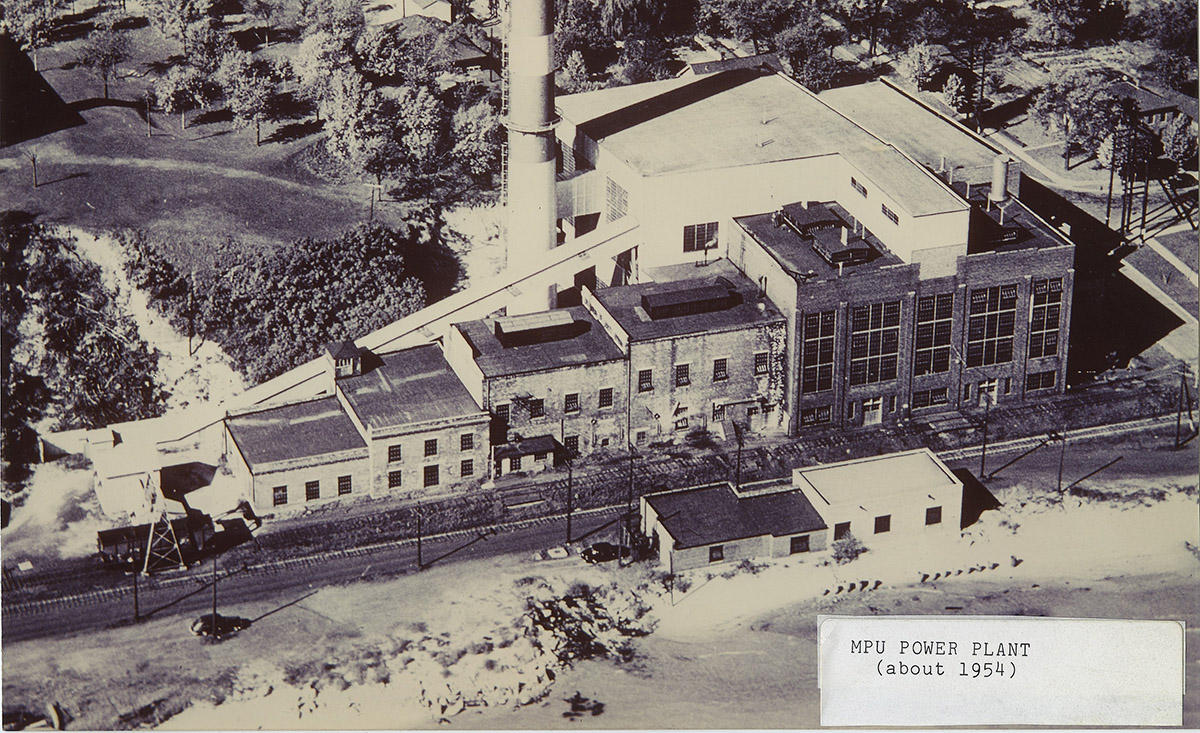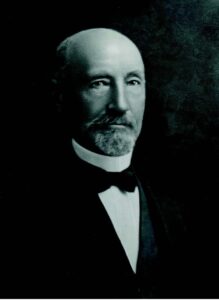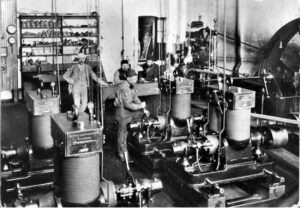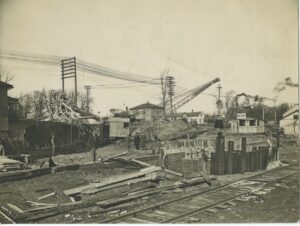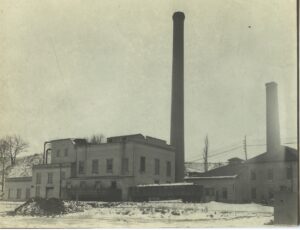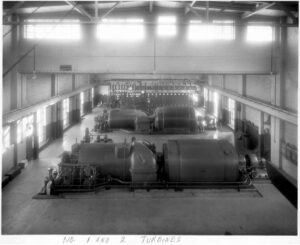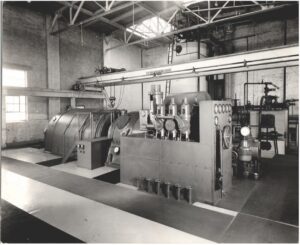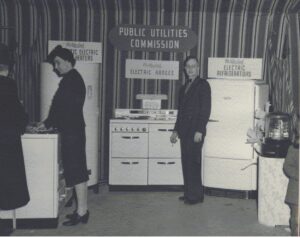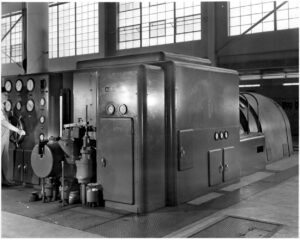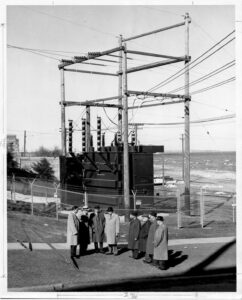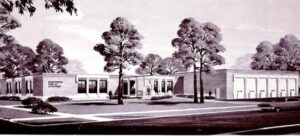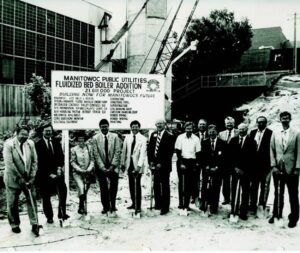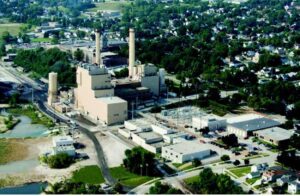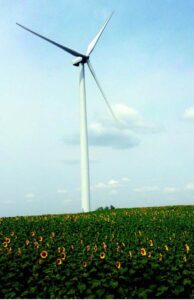The origins of Manitowoc Public Utilities date back to 1889, just ten years after the incandescent electric light bulb was invented by Thomas Edison.
In that year, the City’s aldermen decided to seek contractors to provide electric power to the City, and the contract was awarded to local businessman John Schuette. He constructed the Electric Light Company adjacent to his flour and grist mill on Quay Street, to provide low-cost electricity to Manitowoc’s residents from dusk until 9 p.m.
Also in 1889, the Manitowoc Water Works Company was established by brothers Eugene and T.W. Gray. Their water plant was located on the Lake Michigan shore at what was then the southern city limits.
Fast-forward to 1911, when Manitowoc Mayor Henry Stolze Jr. paved the way for public water and electricity by initiating the City’s purchase of the waterworks, then serving 1,811 customers. In 1914, as the U.S. prepared to enter World War I, the electric plant was purchased. At that time the plant had a capacity of 810 kilowatts and served approximately 2,000 customers.
The City’s Utilities Commission decided to move the electric company facilities since the Quay Street site offered little room for eventual expansion. A decision was made to combine the power company and waterworks facilities on the same site, as they are today, and Manitowoc Public Utilities was born.
MPU Timeline
| 1836 | The land for the settlement of Manitowoc was cleared and staked out following rumors of a gold strike. The rumor proved to be unfounded, but early residents delighted in the abundance of good farmland, plentiful forests, and fresh water. |
| 1847 | Manitowoc began to earn its fame as a shipbuilding center. |
| 1851 | Manitowoc received its first village charter and the citizens put in a successful bid for Manitowoc to become the county seat. |
| 1870 | Manitowoc officially became a city. |
| 1889 | Manitowoc aldermen solicited bids to furnish electric lighting in the City of Manitowoc, and businessman John Schuette offered to supply electricity for half the cost of the nearest bid. Mr. Schuette installed four 20-kilowatt Edison By-Polar generators connected to Corliss-Allis steam engines. The steam was supplied by the boilers in Mr. Schuette’s flour and grist mill, right next door on Quay Street. Mr. Schuette dubbed it the “Electric Light Company.”
In that same year, the Manitowoc Water Works Company was established by brothers Eugene and T.W. Gray. |
| 1904 | John Schuette purchased a gas engine for the Electric Light Company at the St. Louis World’s Fair.
|
| 1911 | Manitowoc purchased the Manitowoc Water Works Company for $236,000 — this was the beginning of public water utility ownership.
Also in 1911, the first steam turbine generator was added to the Electric Light Company, bringing its total production capacity to 810 kilowatts. This was the first alternating current (AC) producing unit in Manitowoc. |
| 1912 | In the general election of 1912, Manitowoc voted to acquire the Electric Light Company. Mr. Schuette was agreeable to the sale and proceedings commenced to determine the value of the property and facilities. |
| 1914 | Manitowoc purchased the Electric Light Company for $137,500. This was the beginning of public electric utility ownership.
|
| 1917 | Increasing efficiency allowed MPU to offer its first rate reduction to electric customers — their electric rates were dropped from 12 cents per kilowatt hour down to 8 cents. |
| 1930 | Manitowoc Public Utilities began selling and servicing electric appliances (at this time there were no electronics or appliance stores, so early electric utilities often became appliance merchants, too).
|
| 1931 | A new era in power generation began in 1931, when the first 5,000 kilowatt Allis-Chalmers steam turbine generating unit was installed. The unit operated on high pressure steam supplied by a Wickes boiler. |
| 1935 | The value of the electric plant and waterworks had grown to $2.72 million, a significant return on the City’s initial investment of less than $400,000 for both utilities.
In this year the Power Plant installed its second 5,000 kilowatt Allis-Chalmers steam turbine generating unit, also supplied with steam from a Wickes boiler.
|
| 1936 | Manitowoc’s downtown was fitted with underground electric cables and graceful double lights on tall concrete poles, replacing the previous electric poles and overhead wires. |
| 1938 | The Reed Avenue Water Tower was completed and commissioned.
|
| 1941 | The electric utility doubled its power production capacity by installing an Allis-Chalmers 10,000 kilowatt — 4160 volt turbine generator. This proved to be good timing, as the advent of Pearl Harbor caused heavy industrial demands soon afterwards.
|
| 1944 | Two new “Ranney” wells were sunk to dramatically increase water collection capacity – they utilized a revolutionary design consisting of one vertical shaft surrounded by horizontal shafts like the spokes of a wheel. |
| 1945 | MPU developed a plan to supply steam and hot water for nearby businesses including the Rahr Malting Company, which became Busch Agricultural Resources, Inc. and is now Briess Malt & Ingredients Company. Over the years this extracted steam system was expanded to provide heat to Lincoln High School, the Manitowoc County Courthouse and Jail, Bio-Technical Resources, First German Lutheran Church and School, and the Courthouse Pub.
|
| 1951 | MPU completed another addition to the Power Plant, bringing an Allis-Chalmers 10,000-kilowatt condensing automatic extraction unit on-line in 1951. This advanced design generated 13,800 volts – more than three times the voltage of the older units.
|
| 1956 | Unit 5, an Allis-Chalmers, preferred standard, 22,000-kilowatt, 13,800-volt turbine generator, went on-line in August of 1956. According to a report from 1957, the complete facilities were installed at a total cost far below others of this type throughout the country. The report also states that this is the first installation in the country to take advantage of vacuum pump efficiency to keep low pressures inside the steam condenser, thereby achieving even greater effectiveness from the turbine.
By 1956, the Power Plant also housed a total of six boilers, ranging in capacity from 60,000 lbs. of steam per hour to 200,000 lbs. The largest, a Wickes boiler, was capable of creating steam at a pressure of 850 lbs. per square inch, at 900 degrees Fahrenheit. |
| 1960 | Water demand continued to grow, so MPU installed a sand filtration system to enable the purification of Lake Michigan surface water to supplement the wells. |
| 1961 | Electric distribution interconnection was achieved, linking Manitowoc’s electric power lines to those of Wisconsin Public Service.
MPU expanded electric production capacity by purchasing a 22-megawatt generator that had originally been slated for delivery to Cuba. The unit had been designed to the exact specifications that MPU needed, and the Utilities were able to purchase the generator at a savings of about $1 million since the original purchasers were unable to complete their agreement due to the Cuban Embargo taking effect that year.
|
| 1970 | The New York Water Reservoir was completed as well as the construction of the administration and storage building now known as the Main Office.
|
| 1991 | The Power Plant was expanded with the addition of a 20-megawatt fluidized bed boiler addition along with a 25-megawatt combustion turbine.
|
| 1995 | The I-43 Industrial Park Water Tower was completed and commissioned. |
| 1999 | The Pressurized Microfiltration Plant was planned and constructed, utilizing state-of-the-art water microfiltration technology. Water is forced through hollow fiber tubes that are about 1/100 the diameter of a human hair, providing continuous microfiltration and creating a physical barrier to micro-organisms. This water treatment system features a unique modular design which allows microfiltration arrays to be added as our customers’ needs grow.
Additional transmission lines were built to reinforce the electrical service to the southwest portion of the City, with the anticipation of servicing the expanded industrial park west of I-43.
|
| 2006 | The 64-megawatt Unit 9 addition to the Power Plant was completed, providing the community with a state-of-the-art circulating fluidized bed boiler to meet energy demands along with environmental standards.
|
| 2007 | The Central Brown County Water Authority (CBCWA) facilities were completed, including a new raw water pumping station and lake intake, a twenty-million-gallon per day submerged microfiltration plant, and a three-million-gallon reservoir and pumping station. The purified water is pumped to Brown County through a 48-inch transmission main traversing 65 miles and crossing beneath two rivers-the Manitowoc and the Fox. |
| 2009 | The Northwest Water Tower was completed and commissioned, further ensuring a safe and adequate water supply. |
| 2010 | Stoker Boilers 5, 6, and 7 were retired due to age and inefficiencies, resulting in an 87 percent reduction of potential emissions of sulfur dioxide and particulate matter on an annual basis. |
| 2013 | To meet renewable resource requirements Manitowoc Public Utilities and Great Lakes Utilities purchased interest in the Lakeswind Wind Farm in Pelican Rapids, Minnesota. The wind farm, consisting of 32 – 1.5 megawatt turbines on 150 foot tall towers, became operational in March 2013. The Rapids Road electric distribution substation was placed into service which, along with reconstructed power lines, increased electric service reliability in Manitowoc’s western portion and improved backup capability system-wide.
|
| 2014 | MPU celebrates 100 years of service to the City of Manitowoc. |
| 2016 | To meet the steam requirements of a large industrial customer, MPU installed two packaged gas-fired firetube boilers, B11 & B12, which produce approximately 100,000 pounds of steam per hour at a pressure of 30 pounds per square inch. |
| 2019 | MPU rolls out an electric Advanced Metering Infrastructure (AMI) system replacing all 18,000 electric meters in the City and installing sixteen data collection points (gateways) on utility poles connected to MPU’s existing fiber optic network. |
| 2020 | CEO and General Manager, Nilaksh Kothari retires after nearly 29 years of service with MPU. The MPU Commission appoints Troy Adams, P.E. as the next General Manager.
MPU completes a two-year decommissioning project at the power plant with removal of stoker boilers 5, 6, & 7, turbine 4 and diesel units 1 & 2. |

